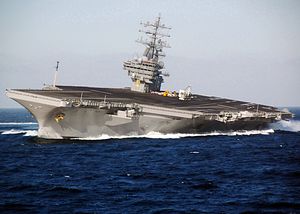An unidentified Chinese attack submarine simulated a cruise missile attack on the U.S. aircraft carrier USS Ronald Reagan on October 24, Bill Gertz over at the Washington Free Beacon reveals.
Details of the incident as well the type of submarine involved remain unknown. Originals reports from early November about the encounter merely stated that a Chinese submarine tailed the USS Ronald Reagan (See: “Closest Encounter Since 2006: Chinese Submarine Tailed US Aircraft Carrier”).
Pentagon officials call it the closest encounter between a People’s Liberation Army Navy (PLAN) ship and an American aircraft carrier since 2006.
The U.S. aircraft carrier was on its way from Yokosuka Naval Base in Japan’s Kanagawa Prefecture, sailing around the southern end of Japan to the Sea of Japan.
The attack simulation, if confirmed, would be in violation of the Code for Unplanned Encounters at Sea, an agreement reached at the 2014 Western Pacific Naval Symposium, between 21 countries including China and the United States.
The chairman of the U.S. House of Representatives Armed Services Committee, Randy Forbes, told the Washington Free Beacon that the incident is just another example of how China can put \ U.S. naval forces in the region at risk.
“Coming on the heels of anti-satellite tests and other demonstrations, this latest incident should be a reminder of the destabilizing course that China is on and the challenges we face in maintaining a stable military balance in the Asia-Pacific region,” Forbes added.
As I noted in a previous post, the bulk of China’s conventional sub fleet consists of 13 Song-class (Type 039) diesel-electric attack submarines and 13 more advanced Yuan-class (Type 039A) submarined equipped with air-independent propulsion (AIP).
Both the Song– and Yuan-class attack submarines are equipped with German-made state-of-the-art diesel engines: the 396 SE84 series is one of the world’s leading submarine diesel engines. However, Chinese submarine technology is approximately still a generation behind that of the U. S. Navy.
Both types of Chinese submarines are armed with YJ-2 (YJ-82) anti-ship missiles. The YJ-82 is a rocket-propelled missile, launched in a buoyant capsule, with a range of 30 to 40 kilometers (16–18 nautical miles).
Song– and Yuan-class attack submarines will also purportedly be fitted with the J-18 vertically-launched, long-range, supersonic anti-ship missile, although an exact induction date for the new weapon is not known.
In October 2009, a Song-class (Type 039) diesel-electric attack submarine unexpectedly surfaced within torpedo range of the American aircraft carrier USS Kitty Hawk.
The USS Ronald Reagan is currently the U.S. Navy’s only forward-deployed aircraft carrier in the Asia-Pacific.

































